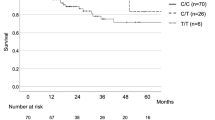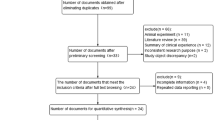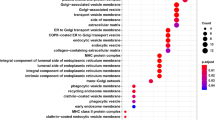Abstract
Drug-induced interstitial lung disease (DILD) is a life-threatening adverse reaction. The Japanese population is more susceptible to DILD as compared with other populations, suggesting its pathogenesis could vary depending on ethnic genetic background. We conducted case-control studies to elucidate the association between DILD and HLA alleles in the Japanese. The 177 clinically diagnosed DILD patients and 3002 healthy controls for exploration and 55 DILD patients and 201 healthy controls for validation were genotyped for four HLA genes. HLA-DRB1*04:05 was significantly associated with DILD (corrected p = 0.014); this was also validated in the other set of patients/controls. Chemical drugs other than protein therapeutics showed this association (p = 1.7 × 10−4) . The Japanese population showed a higher HLA-DRB1*04:05 frequency than most other populations. In conclusion, HLA-DRB1*04:05 could be associated with DILD susceptibility in Japanese individuals, and its high general frequency may explain the high reported incidence of DILD in Japanese.
This is a preview of subscription content, access via your institution
Access options
Subscribe to this journal
Receive 6 print issues and online access
$259.00 per year
only $43.17 per issue
Buy this article
- Purchase on Springer Link
- Instant access to full article PDF
Prices may be subject to local taxes which are calculated during checkout

Similar content being viewed by others
References
Kubo K, Azuma A, Kanazawa M, Kameda H, Kusumoto M, Genma A, et al. Consensus statement for the diagnosis and treatment of drug-induced lung injuries. Respir Investig. 2013;51:260–77. https://doi.org/10.1016/j.resinv.2013.09.001. [Pubmed:24238235]
Amar RK, Jick SS, Rosenberg D, Maher TM, Meier CR. Drug-/radiation-induced interstitial lung disease in the United Kingdom general population: incidence, all-cause mortality and characteristics at diagnosis. Respirology. 2012;17:861–8. https://doi.org/10.1111/j.1440-1843.2012.02187.x. [Pubmed:22563933]
Nishimura T, Tada H, Nakagawa M, Teramukai S, Matsui S, Fukushima M. Lessons from gefitinib-induced interstitial lung disease in Japan: problems in approval, pharmacovigilance, and regulatory decision-making procedures. Pharm Pr (Granada). 2006;4:168–78. https://doi.org/10.4321/S1885-642X2006000400004. [Pubmed:25214906]
min JH, Lee HY, Lim H, Ahn MJ, Park K, Chung MP, et al. Drug-induced interstitial lung disease in tyrosine kinase inhibitor therapy for non-small cell lung cancer: a review on current insight. Cancer Chemother Pharm. 2011;68:1099–109. https://doi.org/10.1007/s00280-011-1737-2. [Pubmed:21913033]
Fricke-Galindo I, LLerena A, López-López M. An update on HLA alleles associated with adverse drug reactions. Drug Metab Pers Ther. 2017;32:73–87. https://doi.org/10.1515/dmpt-2016-0025. [Pubmed:28315856]
Tangamornsuksan W, Chaiyakunapruk N, Somkrua R, Lohitnavy M, Tassaneeyakul W. Relationship Between the HLA-B*1502 allele and carbamazepine-induced Stevens-Johnson syndrome and toxic epidermal necrolysis: a systematic review and meta-analysis. JAMA Dermatol. 2013;149:1025–32. https://doi.org/10.1001/jamadermatol.2013.4114. [Pubmed:23884208]
Phillips E, Mallal S. Successful translation of pharmacogenetics into the clinic: the abacavir example. Mol Diagn Ther. 2009;13:1–9. https://doi.org/10.2165/01250444-200913010-00001. [Pubmed:19351209]
Nicoletti P, Aithal GP, Chamberlain TC, Coulthard S, Alshabeeb M, Grove JI, et al. Drug-induced liver injury due to flucloxacillin: relevance of multiple human leukocyte antigen alleles. Clin Pharm Ther. 2019;106:245–53. https://doi.org/10.1002/cpt.1375. [Pubmed:30661239]
Furukawa H, Oka S, Shimada K, Tsuchiya N, Tohma S. Genetics of interstitial lung disease: vol de nuit (night flight). Clin Med Insights Circ Respir Pulm Med. 2015;9:1–7. https://doi.org/10.4137/CCRPM.S23283. [Pubmed:26056507]
Nishimura M, Toyoda M, Takenaka K, Imamura Y, Chayahara N, Kiyota N, et al. The combination of HLA-b*15:01 and DRB1*15:01 is associated with gemcitabine plus erlotinib-induced interstitial lung disease in patients with advanced pancreatic cancer. Cancer Chemother Pharm. 2016;77:1165–70. https://doi.org/10.1007/s00280-016-3026-6. [Pubmed:27100735]
Furukawa H, Oka S, Shimada K, Rheumatoid Arthritis-Interstitial Lung Disease Study Consortium, Tsuchiya N, Tohma S. HLA-A*31:01 and methotrexate-induced interstitial lung disease in Japanese rheumatoid arthritis patients: a multidrug hypersensitivity marker? Ann Rheum Dis. 2013;72:153–5. https://doi.org/10.1136/annrheumdis-2012-201944. [Pubmed:22887846]
Kaniwa N, Saito Y. Pharmacogenomics of severe cutaneous adverse reactions and drug-induced liver injury. J Hum Genet. 2013;58:317–26. https://doi.org/10.1038/jhg.2013.37. [Pubmed:23635947]
Kamitsuji S, Matsuda T, Nishimura K, Endo S, Wada C, Watanabe K, et al. Japan PGx Data Science Consortium Database: SNPs and HLA genotype data from 2994 Japanese healthy individuals for pharmacogenomics studies. J Hum Genet. 2015;60:319–26. https://doi.org/10.1038/jhg.2015.23. [Pubmed:25855068]
Gonzalez-Galarza FF, McCabe A, Melo dos Santos EJ, Takeshita L, Ghattaoraya G, Jones AR, et al. Allele frequency net database. Methods Mol Biol. 2018;1802:49–62. https://doi.org/10.1007/978-1-4939-8546-3_4. [Pubmed:29858801]
Oka S, Furukawa H, Kawasaki A, Shimada K, Sugii S, Hashimoto A, et al. Protective effect of the HLA-DRB1*13:02 allele in Japanese rheumatoid arthritis patients. PLOS One. 2014;9:e99453 https://doi.org/10.1371/journal.pone.0099453. [Pubmed:24911054]
Di D, Sanchez-Mazas A. Challenging views on the peopling history of East Asia: the story according to HLA markers. Am J Phys Anthropol. 2011;145:81–96. https://doi.org/10.1002/ajpa.21470. [Pubmed:21484761]
Seki T, Ota M, Furuta S, Fukushima H, Kondo T, Hino K, et al. HLA class II molecules and autoimmune hepatitis susceptibility in Japanese patients. Gastroenterology. 1992;103:1041–7. https://doi.org/10.1016/0016-5085(92)90041-v. [Pubmed:1354193]
Duarte-Rey C, Pardo AL, Rodríguez-Velosa Y, Mantilla RD, Anaya JM, Rojas-Villarraga A. HLA class II association with autoimmune hepatitis in Latin America: a meta-analysis. Autoimmun Rev. 2009;8:325–31. https://doi.org/10.1016/j.autrev.2008.11.005. [Pubmed:19041429]
Kawa S, Ota M, Yoshizawa K, Horiuchi A, Hamano H, Ochi Y, et al. HLA DRB1*0405-DQB1*0401 haplotype is associated with autoimmune pancreatitis in the Japanese population. Gastroenterology. 2002;122:1264–9. https://doi.org/10.1053/gast.2002.33022. [Pubmed:11984513]
Nakamura Y, Matsushita T, Sato S, Niino M, Fukazawa T, Yoshimura S, et al. Latitude and HLA-DRB1*04:05 independently influence disease severity in Japanese multiple sclerosis: a cross-sectional study. J Neuroinflamm. 2016;13:239 https://doi.org/10.1186/s12974-016-0695-3. [Pubmed:27599848]
Azuma A, Kudoh S. High prevalence of drug-induced pneumonia in Japan. Japan Med Assoc J. 2007; 50: 405–11. http://www.med.or.jp/english/pdf/2007_05/405_411.pdf (accessed 10 Apr 2019).
Koo LC, Clark JA, Quesenberry CP, Higenbottam T, Nyberg F, Wolf MK, et al. National differences in reporting ‘pneumonia’ and ‘pneumonia interstitial’: an analysis of the WHO International Drug Monitoring Database on 15 drugs in nine countries for seven pulmonary conditions. Pharmacoepidemiol Drug Saf. 2005;14:775–87. https://doi.org/10.1002/pds.1071. [Pubmed:15654720]
Gragert L, Madbouly A, Freeman J, Maiers M. Six-locus high resolution HLA haplotype frequencies derived from mixed-resolution DNA typing for the entire US donor registry. Hum Immunol. 2013;74:1313–20. https://doi.org/10.1016/j.humimm.2013.06.025. [Pubmed:23806270]
Acknowledgements
This study was supported by AMED under Grant Number 18mk0101085j0002. We are sincerely indebted to all participants of this study. We thank Ms. Mika Suzuki for her invaluable help in carrying out this study.
Author information
Authors and Affiliations
Corresponding authors
Ethics declarations
Conflict of interest
The authors declare that they have no conflict of interest.
Additional information
Publisher’s note Springer Nature remains neutral with regard to jurisdictional claims in published maps and institutional affiliations.
Rights and permissions
About this article
Cite this article
Imatoh, T., Ushiki, A., Ota, M. et al. Association of HLA-DRB1*04:05 allele with drug-induced interstitial lung disease in Japanese population. Pharmacogenomics J 20, 823–830 (2020). https://doi.org/10.1038/s41397-020-0172-3
Received:
Revised:
Accepted:
Published:
Issue Date:
DOI: https://doi.org/10.1038/s41397-020-0172-3
This article is cited by
-
Assessing safety concerns of interstitial lung disease associated with antibody-drug conjugates: a real-world pharmacovigilance evaluation of the FDA adverse event reporting system
International Journal of Clinical Pharmacy (2023)



